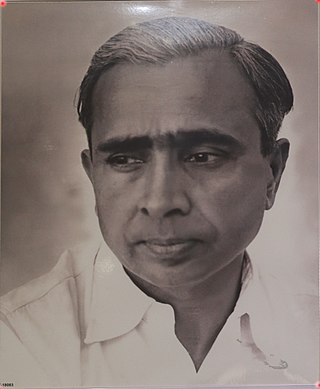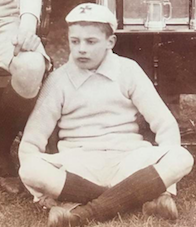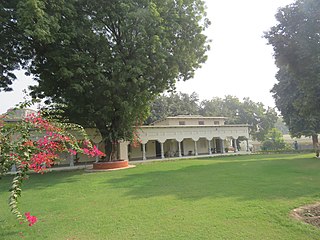
7, Lok Kalyan Marg( 7LKM), formerly 7, Race Course Road, is the official residence and principal workplace of the Prime Minister of India. Situated on Lok Kalyan Marg, New Delhi, the official name of the Prime Minister's residence complex is Panchavati. It is spread over 4.9 hectares of land, comprising five bungalows in Lutyens' Delhi, built in the 1980s, which are the Prime Minister's office, residency zone and security establishment, including one occupied by Special Protection Group (SPG) and another being a guest house. However, even though there are 5 bungalows, they are collectively called 7, Lok Kalyan Marg. It does not house the Prime Minister's Office but has a conference room for informal meetings.
Nehru Planetariums are the five planetariums in India, named after India's first Prime Minister, Jawaharlal Nehru. These are located in Mumbai, New Delhi, Pune and Bangalore, plus there is a Jawahar Planetarium in Prayagraj, where Nehru was born.

Kamala Nehru was an Indian independence activist and the wife of Jawaharlal Nehru, the first Prime Minister of India. Her daughter Indira Gandhi was the first female Prime Minister of India.

The All India Congress Committee (AICC) is the presidium or the central decision-making assembly of the Indian National Congress. It is composed of members elected from state-level Pradesh Congress Committees and can have as many as a thousand members. It is the AICC that elects members of the Congress Working Committee and the Congress President, who is also the head of the AICC.

The Jawahar Planetarium is located in the city of Prayagraj in Uttar Pradesh, India. It was built in 1979 and is situated beside Anand Bhavan the former residence of the Nehru-Gandhi family and now a museum. It is managed by the 'Jawaharlal Nehru Memorial Fund', which has its headquarters at Teen Murti House, New Delhi.

10, Janpath is a public-owned house on Janpath. At the time of Rajiv Gandhi's assassination in 1991, while he was campaigning for a second term as Prime Minister of India, 10, Janpath was his official residence, although he lived at 7, Lok Kalyan Marg while he was Prime Minister. 10, Janpath remains the residence of his widow Sonia Gandhi, who is a former President of Indian National Congress party. The national headquarters of Indian National Congress (INC) is right behind it on 24, Akbar Road. It was the residence of India's second Prime Minister, Lal Bahadur Shastri (1964–1966) and where his body lay in state on 11 January 1966. Today his biographical museum, Lal Bhadur Shastri Memorial is situated at 1, Motilal Nehru Place, adjacent to the complex.

The Anand Bhavan is a historic house museum in Prayagraj, India, focusing on the Nehru family. It was bought by Indian political leader Motilal Nehru in the 1930s to serve as the residence of the Nehru family when the original mansion Swaraj Bhavan was transformed into the local headquarters of the Indian National Congress. Jawahar Planetarium is situated here, which has been striving to inculcate scientific temper among masses through its sky shows on astronomy and science.

Kesava Shankar Pillai, better known as Shankar, was an Indian cartoonist. He is considered the father of political cartooning in India. He founded Shankar's Weekly, India's Punch in 1948. Shankar's Weekly also produced cartoonists like Abu Abraham, Ranga and Kutty, he closed down the magazine during the Emergency of 25 June 1975. From then on he turned to making children laugh and enjoy life.

Lutyens' Delhi is an area in New Delhi, India, named after the British architect Sir Edwin Lutyens (1869–1944), who was responsible for much of the architectural design and building during the period of the British Raj, when India was part of the British Empire in the 1920s and 1930s and 1940s. This also includes the Lutyens Bungalow Zone (LBZ).

The Ministry of Culture is the Indian government ministry charged with preservation and promotion of art and culture of India.
Safdarjung Road is a main road in New Delhi, India, named after the 18th century Tomb of Safdarjung near it. At the north end, the road stretches from the junction of the Teen Murti Marg, Akbar Road, Rajaji Marg and Lok Kalyan Marg, which is a roundabout. At the south end it stretches up to the junction of Prithviraj Road, Tughlaq Road and Sri Aurobindo Marg. There is a single junction/crossing at the Kemal Atatürk Marg and Dr APJ Abdul Kalam Road section.
Padmaja Naidu was an Indian freedom fighter and politician who was the 4th Governor of West Bengal from 3 November 1956 to 1 June 1967. She was daughter of Sarojini Naidu.

The 61st Cavalry Regiment is a horse-mounted cavalry regiment of the Indian Army. It is notable for being one of the largest, and also one of the last, operational un-mechanised horse-mounted cavalry units in the world. Formerly deployed into active conflict, the 61st Cavalry is currently employed on ceremonial occasions, though it can be deployed for internal security or provide military aid to the civil power.

Geeta Kapur is a noted Indian art critic, art historian and curator based in New Delhi. She was one of the pioneers of critical art writing in India, and who, as Indian Express noted, has "dominated the field of Indian contemporary art theory for three decades now". Her writings include artists' monographs, exhibition catalogues, books, and sets of widely anthologized essays on art, film, and cultural theory.

Prime Minister'sMuseum and Library Society is a museum and library in New Delhi, India, which aims to preserve and reconstruct the history of the Indian independence movement. Housed within the Teen Murti House complex, it is an autonomous institution under the Indian Ministry of Culture, and was founded in 1964 after the death of India's first prime minister, Jawaharlal Nehru. It aims to foster academic research on modern and contemporary history. Today, the Nehru Memorial Library is the world's leading resource centre on India's first prime minister. Its archives contain the bulk of Mahatma Gandhi's writings, as well as private papers of Sahajanand Saraswati, C. Rajagopalachari, Bidhan Chandra Roy, Jayaprakash Narayan, Charan Singh, Sarojini Naidu and Amrit Kaur. In March 2010, it launched a digitization project of its archives, and by June 2011, 867,000 pages of manuscripts and 29,807 photographs had been scanned and 500,000 pages had been uploaded on the digital library website. Amongst noted publications of the NMML are Selected Works of Jawaharlal Nehru, Man of Destiny by Ruskin Bond, and Nehru Anthology (1980).

Gyarah Murti is a monument located in New Delhi, India, commemorating the country's struggle for independence under the leadership of Mahatma Gandhi. Devi Prasad Roy Choudhury is credited as its sculptor. An ensemble of eleven statues, ten represent people from diverse sociocultural, religious and economic backgrounds following Gandhi in the lead. Widely believed to depict the Dandi March, the statue has been replicated in other cities in India and was featured on the old 500-rupee currency note.

Robert Tor Russell (1888–1972) was a British architect. In his position as Chief Architect to the Public Works Department of the Government of India, he is primarily associated with the development of the city of New Delhi in the early 1930s. He designed some of the city's most notable buildings and was the architect of Connaught Place, the financial centre of the new capital. Russell also served with distinction during the First World War, and later, after retiring from India, became a civil servant for the British Government.
Abha Narain Lambah is an Indian conservation architect whose eponymous architectural practice has restored several of India's UNESCO World Heritage Sites like the Ajanta Caves, Golconda Fort and Mahabodhi Temple, and Mumbai's Victorian buildings like the Crawford Market, Royal Opera House, Asiatic Society of Mumbai Town Hall and Knesset Eliyahoo Synagogue.
Flagstaff House may refer to:




















